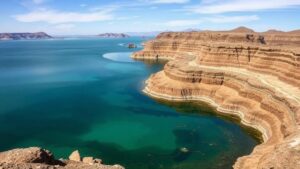Tracing Desert Fossil Locations Using Historical Geological Survey Records
Tracing Desert Fossil Locations Using Historical Geological Survey Records
The study of desert fossil locations is an important aspect of paleontology and geology, contributing to understanding Earths geological history and ancient ecosystems. This article explores how historical geological survey records can be utilized to trace desert fossil locations, providing a basis for further research and discovery.
The Importance of Geological Survey Records
Geological survey records, including maps, reports, and field notes, serve as vital resources in uncovering fossil sites. These records, often archived by governmental and educational institutions, contain data on rock formations, sediment composition, and historical geological events. allow researchers to identify possible fossil-rich areas based on stratigraphy and sedimentology.
Key Historical Geological Surveys
Several significant geological surveys have been conducted in desert regions around the world. Two notable examples include:
- The United States Geological Survey (USGS): Established in 1879, the USGS has conducted extensive studies across various states, including deserts like the Mojave and Sonoran. Their data on stratigraphy and biota provides insights into fossil locations.
- The Geological Survey of Canada: This survey, dating back to the 1880s, has documented various desert ecosystems in Canadian regions, offering valuable geological and paleontological insights.
Applying Historical Records to Locate Fossils
Geological survey records can be leveraged in several ways to trace the locations of desert fossils:
- Analyzing Stratigraphic Data: By examining stratigraphic columns from geological surveys, researchers can locate specific layers where fossils are likely to be found. For example, the Miocene sediments in the California desert have led to numerous discoveries of fossilized marine life.
- Field Survey Integrations: Integrating historical data with modern field surveys can help researchers revisit previously noted locations. For example, many fossil sites in the Cenozoic strata of the Great Basin have been identified using earlier USGS reports.
- Cross-referencing with Fossil Databases: Historical geological survey data can be cross-referenced with contemporary fossil databases such as the Paleobiology Database to check for previously recorded finds, enhancing the depth of research.
Case Study: The Fossils of the Mojave Desert
The Mojave Desert has been the focus of numerous paleontological studies due to its rich fossil record. Historical geological surveys by the USGS have detailed the stratigraphy of this region, outlining various rock formations, such as the Barstow Formation, which dates back to the late Miocene epoch.
A notable discovery was made when researchers examined the archives of the USGS regarding the area around Barstow, California. By analyzing the reports of sediment deposits, it was found that this area had significant deposits of fossilized flora and fauna, indicative of lush environments during its geological past.
Challenges and Limitations
Despite the wealth of information contained in geological survey records, several challenges hinder their utility:
- Access to Archived Records: Many historical records are not digitized and require extensive fieldwork and research at archival institutions.
- Incompleteness of Data: Some surveys lack comprehensive details, which can lead to gaps in locating fossils.
- Geological Changes: Natural events such as erosion may have altered landscapes since surveys were conducted, complicating fossil retrieval.
The Future of Fossil Location Tracing
As technology advances, the integration of Geographic Information Systems (GIS) with historical geological survey data appears promising. GIS can help visualize fossil distribution and predict areas of potential discovery based on geospatial data. The continuous digitization of records and collaborative efforts between geological institutions and universities will also enhance access to critical information for future research.
Conclusion
The tracing of desert fossil locations using historical geological survey records is a multifaceted process essential for understanding Earths history. By utilizing these records effectively, researchers can enhance their findings and contribute significantly to paleontology. Although challenges exist, the ongoing advancements in technology and collaborative research can help overcome these obstacles, paving the way for future discoveries in fossil-rich desert areas.



